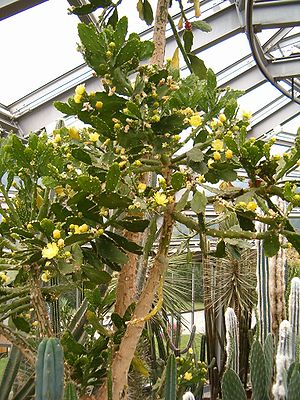Brasiliopuntia brasiliensis
| Brasiliopuntia brasiliensis | ||||||||||||
|---|---|---|---|---|---|---|---|---|---|---|---|---|

Brasiliopuntia brasiliensis |
||||||||||||
| Systematics | ||||||||||||
|
||||||||||||
| Scientific name of the genus | ||||||||||||
| Brasiliopuntia | ||||||||||||
| ( K.Schum. ) A.Berger | ||||||||||||
| Scientific name of the species | ||||||||||||
| Brasiliopuntia brasiliensis | ||||||||||||
| ( Willd. ) A. Berger |
Brasiliopuntia brasiliensis is the only plant species of the monotypic genus Brasiliopuntia in the cactus family(Cactaceae). The botanical name of the genus and the specific epithet brasiliensis refer to the original location in Brazil . Common names are “Urumbeba”, “Mumbeca”, “Mumbebo”, “Facho de Renda”, “Palmatória Grande”, “Palmatória do Diabo”, “Ambeba”, “Arumbeva”, “Gerumbeba”, “Jurubeba” and “Xiquexique de” Sertáo ”.
description
The upright, tree-like Brasiliopuntia brasiliensis reaches a height of 20 meters (or more). It has a pronounced, thorny trunk. The intermediate segments are cylindrical and 20 to 100 centimeters long. The light to dark green end segments are rhomboid to egg-shaped, of uneven shape, narrow at the base and produce leaf-like shoots or flax shoots. The fleshy, light green leaves are small and soon fall off. The areoles have white hair and later develop glochids . The 1 to 3 thorns , which can also be missing, are thin, reddish and up to 15 millimeters long.
The yellow flowers appear near the tip or terminally on the thin-fleshed segments or from the pericarpel of old flowers, open during the day and are up to 6 centimeters long. Hair-like staminodes are located between the inflorescence and the stamens .
The spherical to pear-shaped to elongated, fleshy fruits are yellow, orange-red, red or purple, have a diameter of 3 to 4 centimeters and have striking clusters of dark brown glochids . They contain 1 to 5, very large (6.5 to 10 millimeters), thick, disc-like, laterally compressed, woolly seeds .
Systematics, distribution and endangerment
Brasiliopuntia brasiliensis is widespread in South America . It occurs in Brazil , Paraguay , eastern Bolivia , Peru and northern Argentina . It is naturalized in various places, for example Florida .
Karl Moritz Schumann described the genus as a sub-genus of the Opuntia in 1898 . Nathaniel Lord Britton and Joseph Nelson Rose already considered the possibility of an independent genre in 1919. Alwin Berger finally raised it to the rank of an independent genre in 1926. It was first described as Cactus brasiliensis in 1814 by Carl Ludwig Willdenow .
Brasiliopuntia brasiliensis is in the endangered Red List species the IUCN as " Least Concern (LC) ", d. H. classified not endangered.
proof
literature
- Edward F. Anderson : The Great Cactus Lexicon . Eugen Ulmer KG, Stuttgart 2005, ISBN 3-8001-4573-1 , p. 93-94 .
- Curt Backeberg : Die Cactaceae: Handbuch der Kakteenkunde . 2nd Edition. tape I . Gustav Fischer Verlag, Stuttgart New York 1982, ISBN 3-437-30380-5 , p. 370-375 .
- NL Britton , JN Rose : The Cactaceae. Descriptions and Illustrations of Plants of the Cactus Family . tape I . The Carnegie Institution of Washington, Washington 1919, p. 209 f .
Individual evidence
- ↑ The lines of development of the cacti . 1926, pp. 17-18, 94.
- ↑ Brasiliopuntia brasiliensis in the Red List of Threatened Species of the IUCN 2013. Posted by: Taylor, NP, Machado, M., Zappi, D., Braun, P., Oakley, L., Pin, A. & Ostalaza, C., 2010. Retrieved October 6, 2017.
